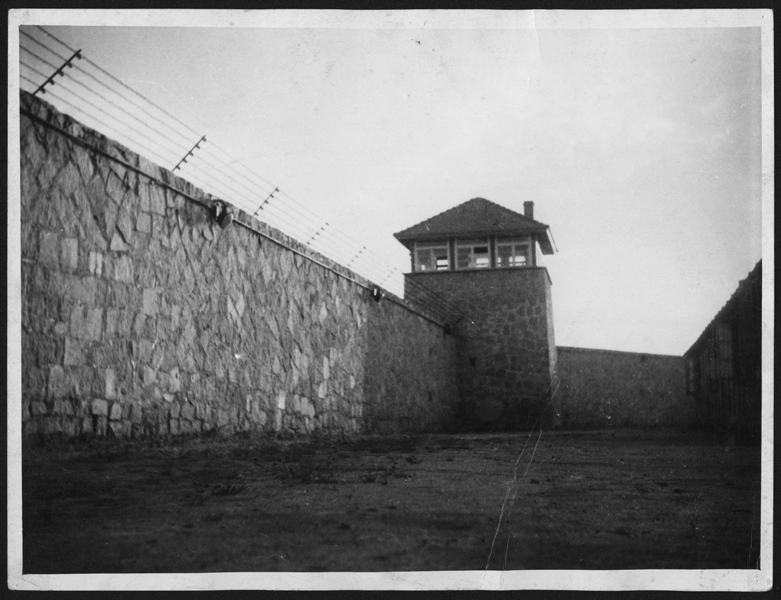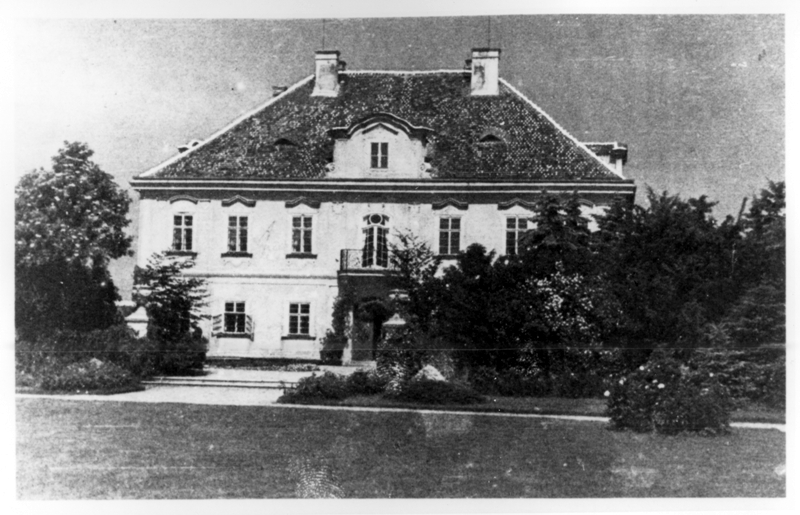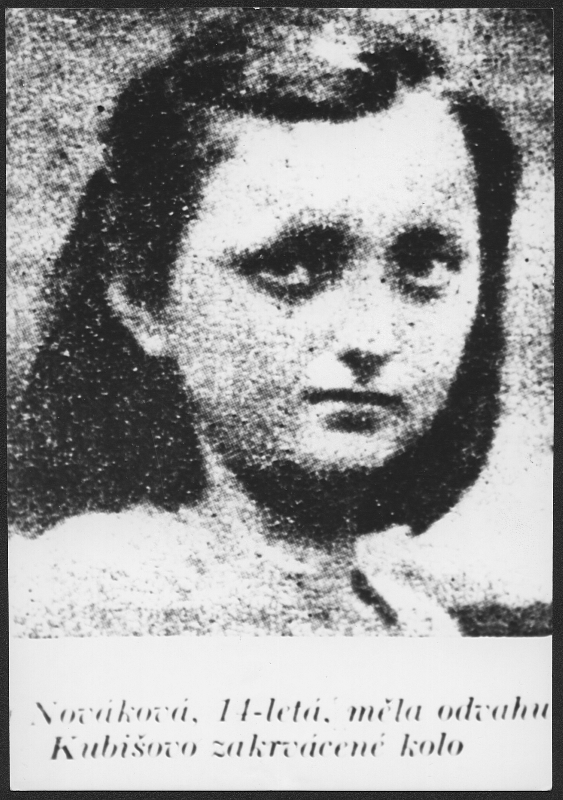
14-year-old Jindřiška Nováková, who took the Kubiš bicycle after the assassination of R. Heydrich was also arrested in the gestapo prison in the Small Fortress. From Terezin she was deported to KL Mauthausen were she was killed on October 23, 1942, APT 4053
This year it is already 70 years since Reinhard Heydrich was assassinated. The situation that occurred in the Protectorate of Bohemia and Moravia afterwards had an impact also on life in the Terezin ghetto and Gestapo police prison in the Small Fortress.
On 28th May 1942, martial law was declared in the Protectorate, which allowed the Nazis to send people to prison or even death without trial. Occupiers primarily concentrated on hunting down assassinators and people who helped them, and arrested and executed thousands of Czech citizens.
GestapoPolice Prison in the Small Fortress
Among those who felt the impact of martial law were students from Roudnice nad Labem. A group of 84 pupils of two Roudnice schools was transported to the Small Fortress on 20th June 1942. The pretext for their arrest was a stating that they were preparing the assassination of Alfred Bauer, the head teacher of German primary school in Roudnice nad Labem (see Newsletter 4/2011).
Several women from Lidice were also placed in the police prison after the village had been burned down.
Prisoners connected to the assassinators J. Kubis and J. Valcik
Since summer 1942, the Gestapo police prison held a group of “parachutists“, as they were called by other inmates, too. They were people related to or helping the assassinators J. Kubis and J. Valcik. Terezin guards wreaked their anger on them and exercised the hardest regime.
There were mainly whole families including children.
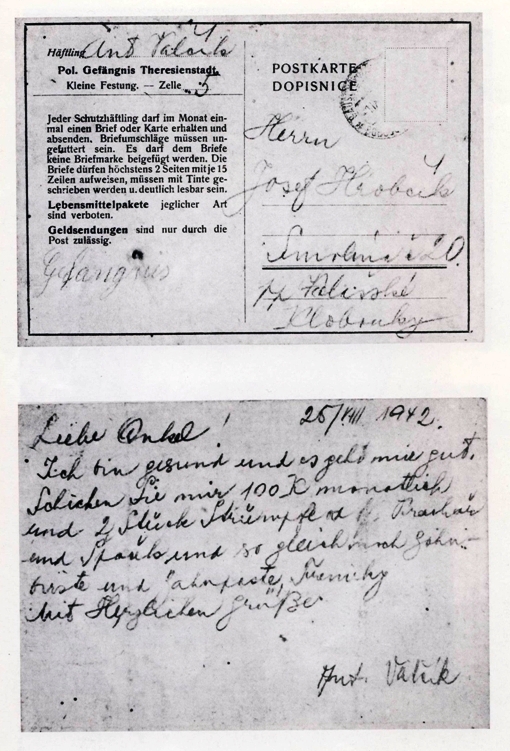
Postal card by Antonin Valčík (brother of Josef Valčík) from the gestapo police prison in the Small Fortress, APT 6912
Not sure what to do with the children, in the end Prague Gestapo office sent two buses of the under 14 years of age to the orphanage in Krc. All inmates present still keep in memory the heartbreaking moments when those children were being taken away from their mothers who feared never to see them again.
On 29th September 1942, the German martial court sentenced 252 people in the operation “Parachutists” to death. None of them was on trial, none was told the sentence. The whole matter around this Terezin group reached its tragic end on 21st October 1942.
How did fellow inmates recall the last hours of life of these innocent people? Here are some insights and messages of Josef Mojzis and Frantisek Rafaj, also imprisoned in the Small Fortress: Late in the evening alarm sounding and line-up of the first courtyard cells. The whole yard was clearly lit up by floodlights. People spoke about a transport. The guards including Jöckl gathered at the courtyard commandant’s office. The received order was read out and then members of Kubis, Valcik, Svatos, Fafka and other families called up by names. Identified people passed to the side yard, where they changed clothes and got formed into 5 lines.
22nd October 1942
In the morning women, brought from the yard, joined the lined-up men and the whole procession of about 300 prisoners left the Small Fortress towards the Bohusovice station. They were constantly prodded and yelled at by the guards. There was a special train waiting for them at the station. Going towards Prague, they had a little chance of being taken to the court. Nevertheless, the train still continued south, to a concentration camp in Austria.
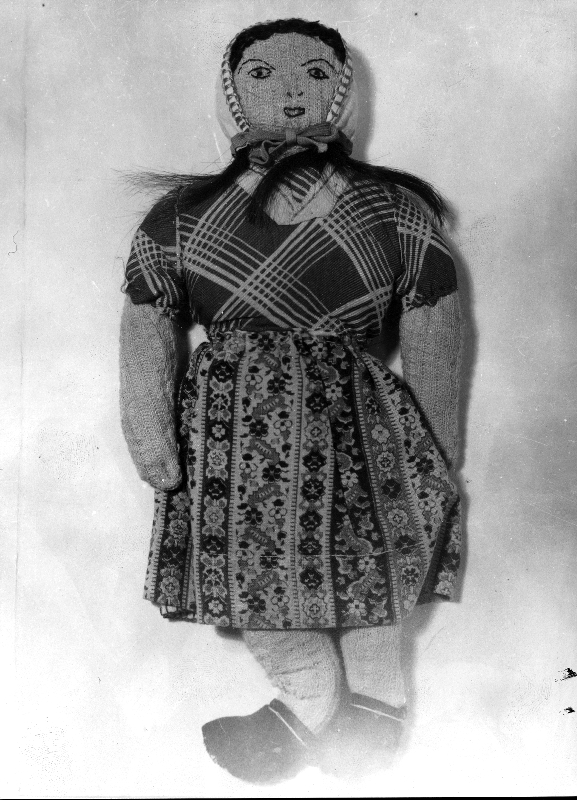
Doll made by Terezie Beňová, related to Josef Valčík. It was sent from the Small Fortress to the children., APT 1509_1
Around midnight they drew in to Mauthausen station. They were further driven several kilometres up to the camp gate, where they were already expecting them. As prisoner Rafaj noticed, women did not come to the local marshalling yard with them (F. Rafaj arrived along with several dozens of other prisoners in the same transport, however he did not belong to the group of relatives and helpers of assassinators. He survived).
23rd October 1942
Still at night, the lined-up men were carefully checked by the SS men under floodlights and then divided into two groups. The first consisted of “parachutists”, the second of the others. A “shower” in the local cellar washrooms followed. As F. Rafaj remembers, he could hear terrible wailing as friends from the first group were being beaten. They ran out all in blood and bruises. Some of them did not survive the rampage. Then the second group went to showers, those even got some clothes. When Kapos drove them out to the courtyard, the first were no more there.
24th October 1942
On that day took place the major liquidation of the group of 252 people transported here from Terezin and accused of hostility to Germany and assisting to the assassination of R. Heydrich. Men were shot to the back of the head, women were gassed. There were also twelve adolescents under 17 years of age in the group.
In early 1943, the relatives of people murdered in Mauthausen received the death notice. Comparing the data on these official documents showed clearly that they were dying minute by minute.
Terezin Ghetto
The assassination and retaliatory events of the Nazi influenced also the Terezin ghetto. The ghetto is closely connected to Lidice tragedy. According to the survivors’ recounting, a commando of 30 men left Terezin on 10th June 1942. They were put on a lorry covered with canvas together with a barrel of chlorinated lime and a pile of pickaxes. The men did not know where they were going. First they thought there had been some mine disaster in Kladno. However, they were brought to Lidice. It was not until they reached Horak’s farm that they finally understood what they were supposed to do. They were digging a mass grave for 36 hours with almost no rest. They got no food and no sleep either. Those who were too tired to work were beaten. After digging up the grave, the Terezin prisoners had to undress dead men and hand all their valuables over to the Nazi. Then they buried them. Under death threat, the Jews had to promise not to talk anywhere about what they had seen and done at Lidice. After their comeback to the ghetto, the men could take a rest for two days and later went back to work.
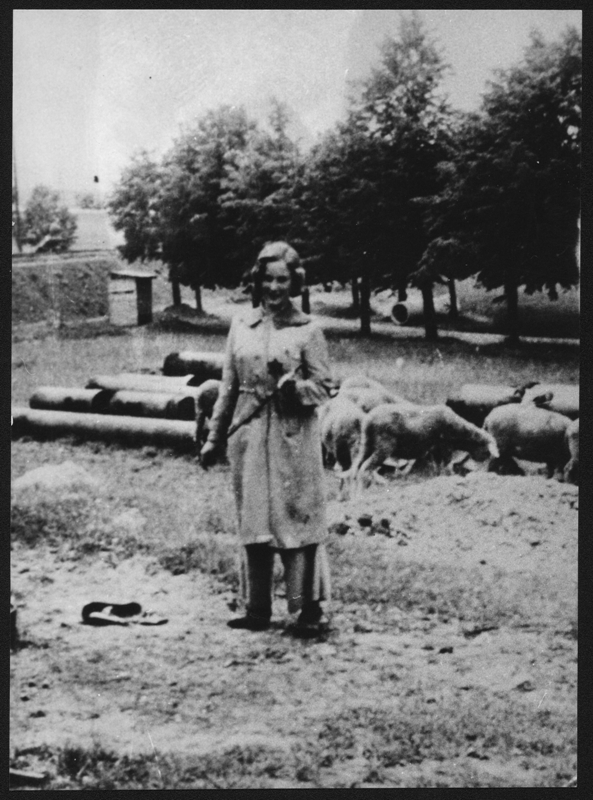
Doris Grozdanovičová, born Schimerlingová, during pasture of the sheep. These were driven to the Terezin Ghetto from burnt village of Lidice, APT 4423
The Nazi brought many things and farm animals from Lidice for their use in Terezin: clothes, carpets, curtains, sewing machines, horses, cows, sheep, goats and hens.
There was a “search operation” in the ghetto on 16th June 1942. Under the police surveillance, Jews had to march in the barrack yards around tables with pictures of a briefcase, a coat and other things which had belonged to the assassinators. Each prisoner had to confirm with signature that they did not know those things.
Commando from Ghetto at Panenske Brezany
The Terezin ghetto was tied to Reinhard Heydrich even after his death, namely to Heydrich’s widow, Lina, who lived in a mansion at Panenske Brezany. In 1943, a separated working commando made of Jewish Terezin ghetto inmates was formed to work at the mentioned mansion. Prisoners usually worked there in horticulture, e.g. they filled up the pond and turned acquired area into vegetable fields, or they watered trees in the mansion’s park. “Fitness exercises” were applied in punishment for the slightest decrease in work attitude (e.g. pushing a wheelbarrow fully loaded with stones etc.). According to witnesses, Lina Heydrich usually stood at the corner window of the building with binoculars and checked prisoners’ work. At the slightest dissatisfaction she complained and made things serious.
In many cases, prisoners from both, the commando sent to Lidice as well as the commando at Panenske Brezany, were later put on eastern transports from the ghetto.
Chl, Se

